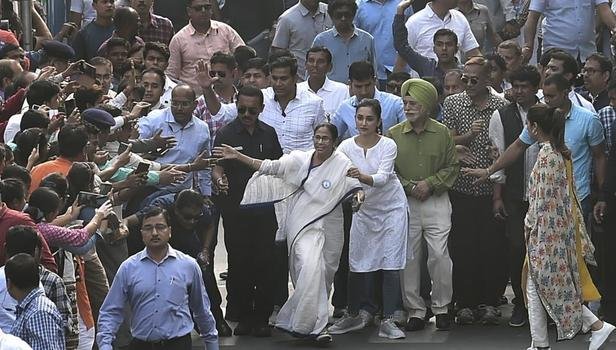Citizenship Amendment Act: Mamta Banerjee government stops NPR updation
18 Dec 2019 ( IBTN News Bureau )
Amid opposition to the Citizenship Amendment Act, the Mamta Banerjee government of West Bengal has stopped the updation of NPR (National Population Register).
In this regard, the Mamta government has sent instructions to all the district authorities.
This order issued on Monday has been said to be a decision taken in public interest.
Mamta has been consistently saying before that that she will not allow NRC and Citizenship Amendment Act to be implemented in her state, but was in a tizzy about NPR.
Opposition parties have pulled up Mamata Banerjee, except BJP, for opposing NRC and supporting NPR.
Now CPM has welcomed Mamta's new decision.
At the same time, BJP says that the work of NPR was being done under the National Census Act, so the decision of Mamta Banerjee is unconstitutional.
What is the reason for temporary ban on NPR? Mamta Banerjee is against NRC. Minorities have a large vote bank in Bengal and are in a decisive position. This vote bank was with the Left for more than three decades. When Mamata came to power in 2011, she also got the support of minority vote bank along with anti-land acquisition movements and in Bengal it is around 30%.
When the list of NRC came to Assam and close to 19 lakh people were out there, it also affected Bengal. Mamta has been strongly opposed to NRC ever since.
The problem of infiltration is more in Bengal than Assam. It has a long border with Bangladesh. Hindu Bengalis have been coming here since partition. With the formation of Bangladesh in 1971, a large number of Hindu Bengalis came from there.
The ruling Trinamool Congress Party said that in view of the protests and violence that is taking place in the state, the government has made a decision temporarily so that people do not get further fear.
In view of the situation arising out of this decision of the Government of Bengal, let us know what is NPR, NRC and Census and how are they different from each other?
Why is a census conducted? Actually, people are counted (census) every 10 years to assess the socio-economic status of every citizen of the country and based on this, to determine the government policies regarding development work in a particular area.
In this, data is collected about village, city dwellers as well as their employment, standard of living, economic status, educational status, age, sex, occupation etc. These figures are used by central and state governments to formulate policies.
The responsibility of conducting the census is with the office of the Registrar General of India and the Commissioner of Census under the Union Ministry of Home Affairs.
The Census Act was passed in 1948 to give it statutory status.
According to the Ministry of Home Affairs of India, the British first carried out a census in 1872 in British India. From then until the census of 1941, caste of citizens was asked in it but after independence of India in 1947, caste was removed from the 1951 census.
By the way, this question has definitely been asked in the census whether you belong to a scheduled caste and what is your caste in it? However, the argument is made in its favor that the Scheduled Castes will be given political reservation in proportion to the population, a provision in the Constitution. Therefore, there is a constitutional need to know their population.
The first census was conducted in 1951 after independence. The census to be held every 10 years has been conducted 7 times since independence.
Currently the data of the 2011 census is available and the 2021 census is in progress.
It takes about three years to prepare it. First, officers are appointed for the census, who go door-to-door, submit personal data and fill the census form by asking people questions.
It consists of questions related to age, gender, educational and economic status, religion, occupation etc. A total of 29 such questions were asked in the 2011 census.
These figures only show what the population is in the country, how many women and how many men are there, what age group they are, which languages they speak, which religion they follow, what is their level of education, how many People are married, how many children were born in the last 10 years, how many people are in employment, how many people have changed their place of residence in the last 10 years, etc. As a rule, the government keeps these private information of the people confidential.
With these figures, the real situation of the citizens of the country reaches the governments and based on this, they formulate their policies.
Now the government has decided to digitize the census. India's Union Home Minister Amit Shah said on November 18 that this time the mobile app will be used in the census. In this, data will be collected in a digital way. That is, it will be the beginning of moving from papers to digital format.
How is NPR different from NRC? The Central Government wants to prepare biometric and genealogical data of the citizens of India and the time has been fixed for September 2020 to release its final list.
This process is not linked in any way to the Census and the National Civil Register (NRC).
NPR, like NRC, does not count citizens. Foreigners who have been living in any part of the country for 6 months will also be added to it.
The goal of NPR is to produce data identifying each citizen of the country.
What is NPR? NPR is a list of common citizens of the country. From 2010, the government launched the National Population Register to submit a database of citizens' identities.
According to the Ministry of Home Affairs, an ordinary citizen is one who has been a permanent resident in any part of the country for at least 6 months or plans to live in another place for the next 6 months.
According to Home Ministry sources, NPR will be made mandatory for all. In this, calculations are being done at panchayat, district, state or national level.
There are 15 categories in the demographic data which include name to place of birth, educational qualification and occupation etc.
For this, both demographic and biometric data will be collected.
Aadhaar is included in the biometric data so that every information related to it will reach the government.
Controversy is also on the basis that this will not protect Aadhaar data.
In 2011, when a comprehensive database was created, information about Aadhaar, mobile number and ration card was collected.
But it was updated in 2015 and citizens will now have to provide PAN card, driving license, voter ID and passport information to get their name registered.
Under section 14 (a) of the Citizenship Act 1955, it is mandatory to enroll in it to become a lawful citizen.
Assam will not be included in this because NRC has been implemented there.
What is NRC? The National Register of Citizens (NRC) will know who is a citizen of India and who is not.
There have been several violent agitations in the northeastern state of Assam on the issue of illegal people coming from Bangladesh.
In 1985, the then Rajiv Gandhi government entered into an agreement with the Assam Gana Parishad, called the Assam Accord, under which only Bangladeshi who came to Assam before 25 March 1971 would be granted citizenship.
But for a long time it was kept in cold storage. Then in 2005, the then Manmohan Singh government started work on it.
Following the Supreme Court's order in 2015, the work gained momentum and the NRC was drafted.
That is, NRC was originally implemented for Assam on behalf of the Supreme Court.
NRC was published in August 2019. But close to 19 lakh people were excluded from the published register due to lack of proper documents.
Those excluded from this list were given time to prove their citizenship with valid certificates.
However, it took a stir from the road to the Parliament.
(Click here for Android APP of IBTN. You can follow us on facebook and Twitter)
Share This News
About sharing
-
 21 Oct 2024
What is behind the Canada-India fallout?
21 Oct 2024
What is behind the Canada-India fallout?
What is behind the Canada-India fallout?
Monday, October 21, 202...
-
 02 Sep 2024
Supreme Court of India takes a tough stand on bulldozer action, what did the Supreme Court say?
02 Sep 2024
Supreme Court of India takes a tough stand on bulldozer action, what did the Supreme Court say?
Supreme Court of India takes a tough stand on bulldozer action, what did the Suprem...
-
 20 Aug 2024
After opposition's protest, Modi government requested UPSC to cancel lateral entry
20 Aug 2024
After opposition's protest, Modi government requested UPSC to cancel lateral entry
After opposition's protest, Modi government requested UPSC to cancel lateral en...
-
 20 Aug 2024
What did the Supreme Court say on the Kolkata rape-murder case?
20 Aug 2024
What did the Supreme Court say on the Kolkata rape-murder case?
What did the Supreme Court say on the Kolkata rape-murder case?
...
-
 20 Aug 2024
International Criminal Tribunal decided to investigate nine people including Sheikh Hasina
20 Aug 2024
International Criminal Tribunal decided to investigate nine people including Sheikh Hasina
Many plans are being made from India to crush the revolution in Bangladesh: Banglad...


